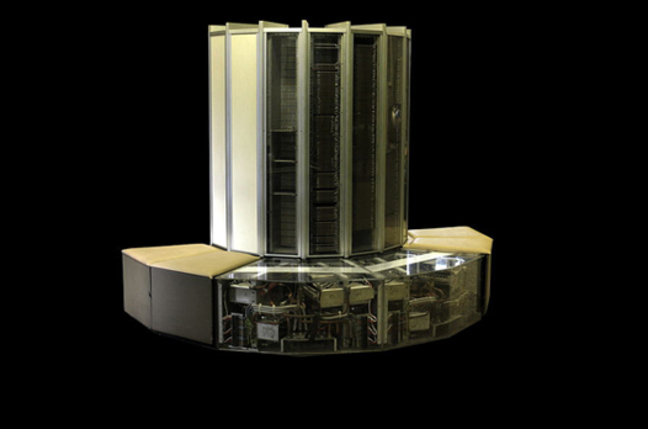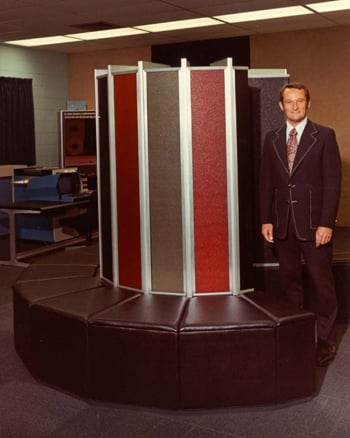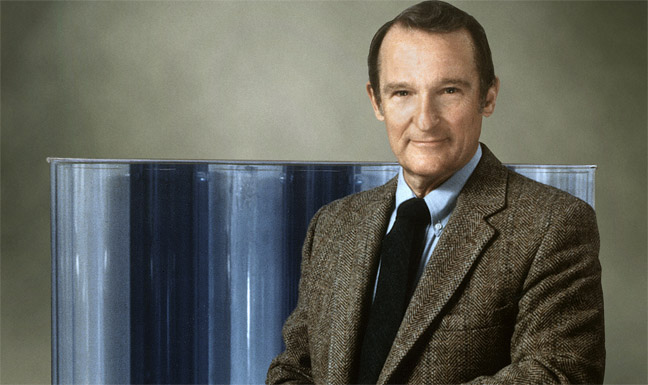


Posted on 10/02/2015 6:56:09 PM PDT by dayglored
Before Steve Jobs, there was Seymour Cray – father of the supercomputer and regarded as something close to a God in the circles he moved in.
Jobs’ Apple Computer is reputed to have bought one of Seymour’s massive machines back in the day: a Cray, to design the brand-new Macintosh personal computer.
This would have been a significant moment for a man of Jobs' character, not prone to flattering the inventions or ideas of others. In return, Cray is said to have quipped that he'd bought a Mac to design the next Cray.
Cray – who would have been 90 years old this week – was the engineering brain behind a family of systems that broke ground in architecture and performance. They broke new ground on price, too: Cray’s computers cost hundreds of thousands of dollars, with the Cray-1 weighing in at $8.8m – an estimated $34m in today’s money.
This meant Crays could be afforded only by the top elite boffins in the arenas of science and the military, who used them to crunch vast models on weather prediction and the potential fallout from nuclear bombs. Such systems were out of the price range of even the biggest private firms.
Irony, indeed, given Jobs’ collaborator Steve Wozniak built the Macintosh in order to democratise computing, as he told your correspondent back in 2011.
Remarkably, and despite the price, it was Cray’s computers which dominated high-performance computing (HPC) for 30 years, seeing off even the mighty IBM. Buying a Cray became like buying IBM elsewhere: it wouldn't get you fired.
(Excerpt) Read more at theregister.co.uk ...




Ping for your respective lists.
Cray wasn’t Jobs.
Cray was Wozniak.
Well stated.
Donald Trump and Ted Cruz are Crays. The GOPe RINOs are TRS-80s. The DemonKKKrats are broken abacuses.
No, Cray was better than Woz + Better than Jobs.
Fact.
I worked there.
I heard from a reputable source that when the first CDC came up in the Eng Lab, Seymour Cray sat down in front of it, and using the front panel data switches, toggled in the entire binary boot loader program BY HAND FROM MEMORY.
I tend to believe that. But I don't recall whether they said the loader was in octal or hex...
You Sir, know what you are talking about!
Woz is a coding and hardware genius!
His 6502 assembly code to control the 5.25 disk drive in software from the Apple II was amazing. He eliminated almost all of the expensive hardware interface.
Jobs was a so-so coder and had no hardware skills to speak of.
He was a creative business genius though.
Good Hunting... from Varmint Al
I read somewhere that the Cray 1 ran at 170Mips
I have 25 cent 32 bit micro-controllers that can do better than that.
The 100mhz ARM that controls an ordinary SD card is more powerful.
We live in amazing times :-)
I just looked at your Freeper page, and then at your engineering page... impressive my FRiend.
I love meeting someone smarter than myself... I think we would enjoy each others company :-)
I used to toggle in programs in binary and after a while it becomes like playing music from memory on a keyboard. Not as difficult as you think.
Yes, it's very much like playing music! (I play piano).
My first hands-on experience with a small computer was a PDP-8e at college, with a paper tape punch and a teletype. 4K 12-bits words of core, and front-panel bat-handle toggle switches for programming it from scratch.
The reason I mentioned the story about Cray is that I toggled the PDP-8 boot loader in by hand (in octal) many times -- it was just enough to run the punched-paper tape reader so you could read in the binary image loader, which in turn could load in.... the line editor. Or the assembler... or your program...
The PDP-8 boot loader was probably tiny compared to the one for the bigger machines, but it gave me an appreciation...
First two Crays off the production line went to Fort Meade, MD. You can guess who bought them.
Some are interviews with Mr. Cray, others are video recordings of speeches he gave. I believe there is a "story of his life" video too. All are worth watching.
One story I particularly liked was about how they tested the circuit boards for the liquid-cooled Cray 3, an all gallium-arsenide supercomputer that was far ahead of its time.
The circuit boards generated so much heat that they could only operate continuously when submerged in Fluorinert coolant. This of course made it very difficult to attach scope probes and logic analyzers to the various signal pathways.
The solution was a test stand that could run a board in air, but only for one millisecond at a time. The engineers would set up test vectors, then press a button to run for a millisecond, during which time the board would execute something on the order of a million clock cycles worth of processing.

I memorized the loader in octal, and my fingers soon learned the binary: 5 was up-down-up and 1 was down-down-up and so on (followed by deposit-next, of course)...
I still have dreams about that period of computing in my life (early 70's). It shaped the rest of my life.
I wish I'd known Seymour Cray. Must have been a helluva guy.
The electronics dictated the shape. Each wire of the backplane had to be made to exact and precise length because the ECL (emitter-coupled-logic) was very, very fast in its day. It was also power-hungry, incredibly electrically noisy and hard to get working reliably.
As I recall, there were exactly four (4) different types of small-medium scale logic circuits in the CPU.
I casually interviewed for field engineering there early in one of my careers but they wouldn’t even look at you if you didn’t have 10 years of experience. And you had to have an unusual skillset - high-speed logic diagnostics AND HVAC (refrigeration was built-into the computer).
You could make a case that what Wozniak did with finesse and as little money and chips as possible, Cray went the other way - that machine really was a “money was no object” computer.
Disclaimer: Opinions posted on Free Republic are those of the individual posters and do not necessarily represent the opinion of Free Republic or its management. All materials posted herein are protected by copyright law and the exemption for fair use of copyrighted works.